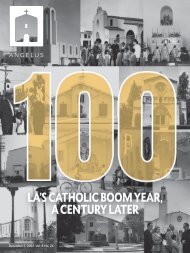Angelus News | May 31, 2019 | Vol. 4 No. 20
The six transitional deacons to be ordained to the priesthood June 1 by Archbishop José H. Gomez pose outside the Cathedral of Our Lady of the Angels. They include an architect, a music producer, and a scientist. Starting on page 10, they each speak to Angelus News about the paths their vocations took them on and why they believe the priesthood is “worth it” more than ever in 2019.
The six transitional deacons to be ordained to the priesthood June 1 by Archbishop José H. Gomez pose outside the Cathedral of Our Lady of the Angels. They include an architect, a music producer, and a scientist. Starting on page 10, they each speak to Angelus News about the paths their vocations took them on and why they believe the priesthood is “worth it” more than ever in 2019.
- No tags were found...
Create successful ePaper yourself
Turn your PDF publications into a flip-book with our unique Google optimized e-Paper software.
more than one stint as executive<br />
director of the Central City East Association’s<br />
Downtown Industrial District<br />
Business Improvement District.<br />
There are some 45 “BIDs,” as they<br />
are called, throughout Los Angeles,<br />
including eight in downtown alone.<br />
She started the first one back in<br />
1993 in the historical theater district<br />
on Broadway. Their stated purpose<br />
is to enhance safety, maintenance,<br />
economic development, and communication<br />
programs beyond what the<br />
city can provide.<br />
But Lopez said her BID today —<br />
which takes in 49 square blocks from<br />
San Pedro to Alameda streets between<br />
3rd Street to Olympic Boulevard —<br />
has had to take on much more serious<br />
and basic day-to-day responsibilities.<br />
Why? Because it encompasses Skid<br />
Row, home to the largest number of<br />
unsheltered homeless in the nation.<br />
“Our commercial property owners<br />
here tax themselves $2 million annually<br />
for our services, which were never<br />
intended to deal with this human disaster,”<br />
she told <strong>Angelus</strong> <strong>News</strong> during a<br />
ride-along last fall, shaking her head.<br />
“The job with business improvement<br />
districts is to make the sidewalks look<br />
nice and empty trash cans. You know,<br />
make the place look inviting. We’re<br />
not supposed to be a response to a<br />
human catastrophe.”<br />
At 6th and Crocker streets, we<br />
approached a blue, tarped tent<br />
stretching 50 feet. One pitbull stood<br />
guard while another dozed. A couple<br />
of young men wearing pressed white<br />
T-shirts over baggy khaki shorts were<br />
standing around smoking.<br />
They were selling a strain of marijuana<br />
laced with more addicting drugs,<br />
Lopez explained. And even though<br />
the combination can make people<br />
violently sick, she said the demand<br />
stays high.<br />
Then Lopez pointed out a brick<br />
storefront with no windows.The small<br />
business, like a lot here, dealt in<br />
textiles, selling to the nearby fashion<br />
district.<br />
The owner, a BID member, has<br />
complained when tents were so close<br />
together he couldn’t make deliveries<br />
or receive buyers. He told her recently<br />
that he came out to ask a guy if he<br />
could make some space because he<br />
had a special delivery coming in.<br />
The guy lifted up his shirt, showing<br />
a pistol stuck in his waistband, and<br />
demanded, “Make me!”<br />
“<strong>No</strong>w look,” observed Lopez near<br />
San Pedro and 6th streets, looking<br />
out the front windshield at a couple<br />
sprawled on an Army blanket across<br />
the sidewalk between tents.<br />
“Human beings shouldn’t live like<br />
this. People who should be qualifying<br />
for housing, people who should be<br />
getting mental health help are instead<br />
laying on the sidewalk here just<br />
looking to see how they can get their<br />
next high.<br />
“I think mental illness is expressing<br />
itself more openly now, too, because<br />
I see so many people down here who<br />
are just lost. I mean, you can tell<br />
they’re mentally ill. And they’ve found<br />
their way here, I think, to quiet the<br />
voices inside their head. And the drug<br />
dealers are here to service them.”<br />
‘Camping atmosphere’<br />
In <strong>No</strong>vember <strong>20</strong>16, LA City voters<br />
overwhelmingly approved Proposition<br />
HHH, authorizing $1.2 billion in<br />
bonds to build or rehab 10,000 housing<br />
units for people who are homeless.<br />
Four months later, Los Angeles<br />
County voters passed Measure H, a<br />
quarter-cent sales tax on themselves.<br />
An estimated $355 million a year for<br />
10 years was promised to be raised,<br />
which would provide so-called “wraparound”<br />
services to go with the new<br />
housing and help the homeless transition<br />
into stable, affordable housing.<br />
Those services include mental health<br />
and addiction counseling, money<br />
management, and job counseling.<br />
A different ‘BID’<br />
Lopez said her BID is “far from that<br />
beautification point of what BIDs are<br />
supposed to do.”<br />
With three dump trucks, the Skid<br />
Row BID does pick up between five to<br />
seven tons of trash daily, and her hired<br />
15 formerly homeless street workers<br />
from the job-training Chrysalis Center<br />
sweep the streets regularly.<br />
But much of their time is spent dealing<br />
with crisis calls from local businesses<br />
to clean up feces, urine, and<br />
vomit in front of their establishments<br />
with “targeted” pressure washing from<br />
another truck (not to be confused with<br />
the block-by-block pressure washing<br />
the city’s sanitation department regularly<br />
does).<br />
A private security force of seven<br />
workers often has to go out with them<br />
for protection.<br />
Estela Lopez, executive director of the Central City East Association, has worked on Skid Row for <strong>20</strong><br />
years. “I’m watching people not live on Skid Row,” she said. “I’m watching them die on Skid Row.”<br />
VICTOR ALEMÁN<br />
<strong>May</strong> <strong>31</strong>, <strong><strong>20</strong>19</strong> • ANGELUS • 21


















